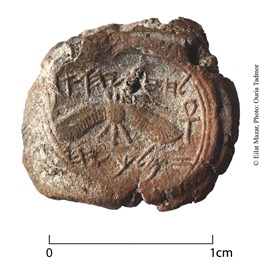A personal seal impression belonging to King Hezekiah has been discovered in excavations south of Jerusalem’s Temple Mount. The tiny inscription reads, “Belonging to Hezekiah (son of) Ahaz king of Judah,” and is the first of its kind to be discovered in an excavation.
From a press release from the Hebrew University:
Measuring 9.7 X 8.6 mm, the oval impression was imprinted on a 3 mm thick soft bulla (piece of inscribed clay) measuring 13 X 12 mm. Around the impression is the depression left by the frame of the ring in which the seal was set.
The impression bears an inscription in ancient Hebrew script:
and a two-winged sun, with wings turned downward, flanked by two ankh symbols symbolizing life.
The bulla originally sealed a document written on a papyrus rolled and tied with thin cords, which left their mark on the reverse of the bulla. This bulla came to light, together with many pottery sherds and other finds such as figurines and seals, in Area A of the excavations (2009 season), supervised by Hagai Cohen-Klonymus.
The bulla was discovered in a refuse dump dated to the time of King Hezekiah or shortly after, and originated in the Royal Building that stood next to it and appears to have been used to store foodstuffs. This building, one of a series of structures that also included a gatehouse and towers, was constructed in the second half of the 10th century BCE (the time of King Solomon) as part of the fortifications of the Ophel — the new governmental quarter that was built in the area that connects the City of David with the Temple Mount.

The bulla was found together with 33 additional bullae imprinted from other seals, some bearing Hebrew names, their reverse showing marks of coarse fabric and thick cords that probably sealed sacks containing foodstuffs.
The full press release, along with a 10-minute video, is posted here.
